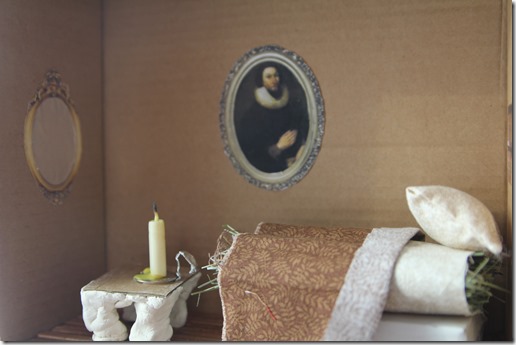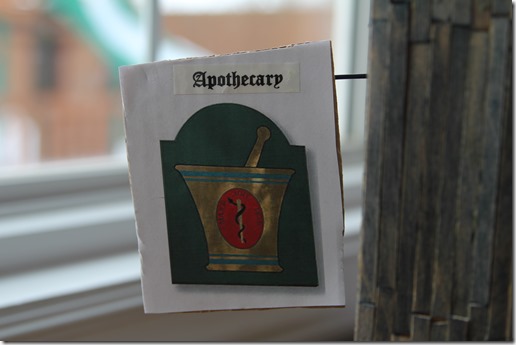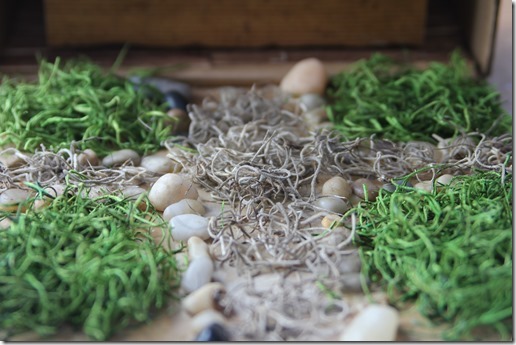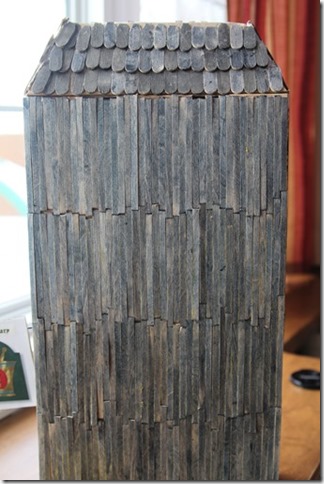Part of the fifth grade class curriculum includes study of Colonial America and every year the students create a colonial village. Because of the connection with Bill and medicine, Walker chose the role of the apothecary.
Last year several friends suggested we look carefully at the villages to get ideas for this year but alas, I didn’t listen well enough. The assignment stipulated that we spend no more than $5 on the entire project. Supposedly, creativity and workmanship are more valued than a shoe box filled with big box store doll house supplies. This, however, made the assignment more challenging.
Walker worked really hard on this assignment and put in excess of nine hours. He built it over at least two weekends and that does not include the time he spent researching about apothecaries in the 1700s. Now, enough of the parental griping. Let’s take a tour.
Here you can see the two story dwelling of the apothecary. There is a bed made of hay with a linens from Mom’s stash of fabrics. The bed platform is an inverted matchbox and the pillow is hand sewn (by Walker) and stuffed with fiberfill.
The night stand is of the finest air clay and holds a candlestick made of a shortened birthday candle with a quarter base. The handle is crinkled aluminum foil. On the wall is a portrait of Governor John Winthrop, a bookshelf and a mirror.
 Winthrop was the founder of the Massachusetts Bay Colony and also provided apothecary services. The hardwood floors are made from pieces of cervical scrapers that we cut down and stained with shoe polish.
Winthrop was the founder of the Massachusetts Bay Colony and also provided apothecary services. The hardwood floors are made from pieces of cervical scrapers that we cut down and stained with shoe polish.
On the first floor we have the apothecary where prescriptions would have been made. The counter was constructed of wood pieces leftover from an old entertainment center. The apothecary would have used a mortar and pestle to grind herbs into powders. The mortar is a dip bowl from IKEA and the pestle is made of air clay. There is also a feather pen, a jar of ink and a recipe for the cure for the bite of a mad dog. See those men on the wall? They are Cosmas and Damian, the patron saints of medicine and the apothecary.
At the far right of the counter is the scale used to weigh ingredients. The scale itself is made of two pennies, copper wire and a toothpick. Additionally, one will see bottles filled with ingredients from our spice drawer including ground turmeric, popcorn salt, poppy seeds, oregano and dill. To represent the leeches, we used meal worms. Behind the counter is the apothecary’s library of books.
Back on the wall is a picture of the small drawers that would have been in an apothecary.
In front of the shop was the apothecary’s garden. Walker lined it with rocks to separate the various herbs that would have been grown. We used different kinds of moss we have had from various craft projects.
Finally, the exterior of the apothecary was made from more stained cervical scrapers. The shingles were from one end of the scraper and each one was hand cut.
Our total expenditures were $3.00 for the glass jars, $0.50 for the candlesticks, and $0.02 for the scale bringing us in way under budget. Now we just need to turn this project in and see how Walker does.








Impressive! And where does Bill get cervical scrapers as a pediatrician?? How big is the entire thing?
amazing…lot of hard work – esp. finding meal worms to use!
Very impressive. Walker must be very pleased with how much he learned on all levels.
So much work goes into Walker’s projects! I’m always impressed with the commitment he has to his projects.
xoxo Kim